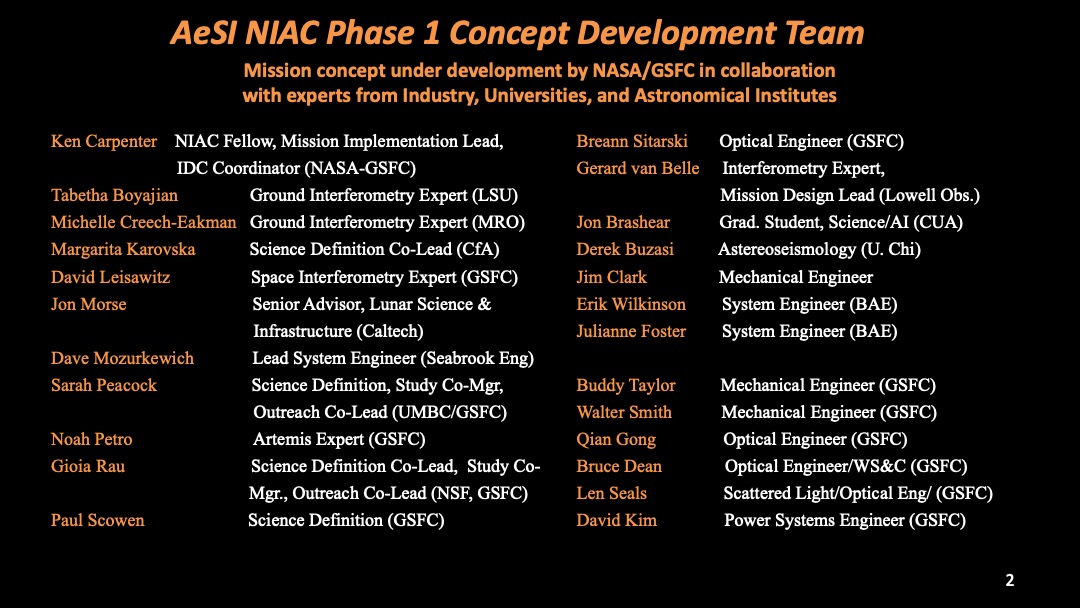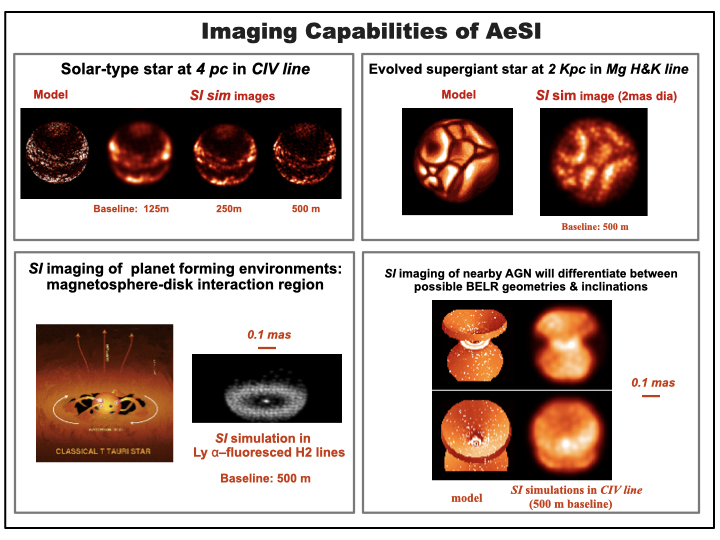AeSI - Artemis enabled Stellar Imager
NASA's return to the Moon for the long-term offers significant opportunities to take practical steps towards high-impact scientific capabilities. One candidate is extremely high-resolution interferometric imaging at visible and ultraviolet wavelengths. The AeSI Team, with support from the NASA Innovative Advanced Concepts (NIAC) Program, is therefore examining the feasibility of building an UV/Optical interferometer, named the Artemis-enabled Stellar Imager (AeSI), on the lunar surface. This observatory can resolve the surfaces of stars, probe the accretion disks surrounding nascent stars and black holes, and begin the technical journey towards resolving surface features and weather patterns on the nearest exoplanets. A lunar interferometer has advantages over Earth-based facilities: longer coherence times (instrumentally driven 10-100+ seconds vs. the atmospheric limit of a few milli-seconds!) mean higher sensitivity, the vacuum environment requires a simpler infrastructure (e.g., delay lines need not be enclosed), and observations can be obtained at UV wavelengths not accessible to the ground. It also has advantages over a space-based free-flyer by enabling flexible station keeping while eliminating the need to develop millimeter-level-accuracy free-flying. A fully developed facility will be large, but it could be built and deployed in stages. For our Phase I NIAC design we chose to start with a 15-element elliptical array with a major axis of up to 1-km that could later be expanded to 30-elements in one or more stages, though we could start with as few as 7-elements if the situation required. Whatever our starting configuration, the baselines and the number of telescopes can be increased, and larger telescopes can be inserted, as desired. Each of these upgrades can be accomplished with minimal disruption of the rest of the system.
Artist's Drawing of our Phase I AeSI concept - an initial 15-element system that could be built as a first step in a staged-development scenario, to reach the end goal of 30 primary mirror stations (Britt Griswold/GSFC).
AeSI Concept Development Team
The NIAC Fellow and Principal Investigator for the Artemis-enable Stellar Imager (AeSI) concept development is Dr. Kenneth Carpenter of NASA Goddard Space Flight Center's Exoplanets and Stellar Astrophysics Laboratory. He leads a collaborative team of experts with extensive experience with ground-based interferometers, optics, engineering, lunar surface characteristics, the Artemis program, and with the development and operation of space missions.
Science Goals
The astonishing science enabled by AeSI (see the figure below) includes: 1) imaging the surfaces of nearby (<4pc) solar-type stars and more distant supergiants (>2kpcs), to observe magnetically driven activity (plages, starspots, convection). Such studies will improve our understanding of the solar/stellar dynamo and our ability to forecast future solar/stellar activity cycles and their impact on "space weather" on Earth and on the habitability of extrasolar planets, 2) imaging accretion disks around nascent stars, and 3) imaging the central engines of Active Galactic Nuclei (AGN).
Technical ApproachWith NIAC support we are investigating the details of building a long-baseline, high-resolution optical imaging interferometer on the lunar surface. A 1996 study (Bely et al., 1996) examined the trade-offs between placing kilometer-sized interferometers on the lunar surface vs. designing them as free-flyers in open space. The authors concluded that, in the absence of a pre-existing human infrastructure on the lunar surface to provide power and on-going maintenance, it was better to pursue space-based free-flyers. Thus, previous studies of interferometers in space concentrated on free-flying designs. However, now a lunar infrastructure is foreseeable as part of the Artemis program and it is compelling and timely that we investigate building interferometers on the lunar surface. Our Team aims at obtaining the same level of detailed study as was done for large baseline, free-flying interferometers during the 2003-2005 Vision Mission Studies, to be prepared to take advantage of such lunar infrastructure. We have used the results of the 2003-2005 Vision Mission (VM) Study of a 0.5 km diameter UV-optical free-flying space interferometer called Stellar Imager (SI) (Allen et al., 2008) to inform our design of a lunar-based facility. The construction of interferometers beyond the surface of the Earth is technically challenging and will benefit enormously from smaller precursor or full-up missions on the lunar surface, where a mix of human and, potentially, robotic support will be available to build, debug, and maintain it.
Documents and Videos
- AeSI NIAC Phase I Final Report (PDF)
- Long Outreach Video (5:50, includes interview with NIAC Fellow)
- Short Outreach Video (2:16, no interview)
- NAS Panel on Astronomy from non-polar Regions of the Moon (9/24/25) Slides (PDF)
- Shore Leave Science Fiction Convention - AeSI Science Talk (07/12/25) Slides (PDF)
- NAS Panel on Astronomy from non-polar Regions of the Moon (6/11/25) Slides (PDF)
- NRL Colloquium (2/10/25) Slides (PDF)
- NOIRLab/Steward Observatory Colloquium (12/3/24) Slides (PDF)
- AeSI NIAC 2024 Symposium (9/10/25) Poster (PDF)
- AeSI NIAC 2024 Symposium (9/10/25) Slides (PDF)
- NIAC AeSI Orientation Slides (PDF)
- NIAC AeSI Orientation Poster (PDF)
- Presentation on "Imaging the Surfaces of Distant Stars with Sub-Milli-Arcsec Resolution: Extending Ground-Based Interferometry into Space (PDF, animated PPTX available upon request)"





